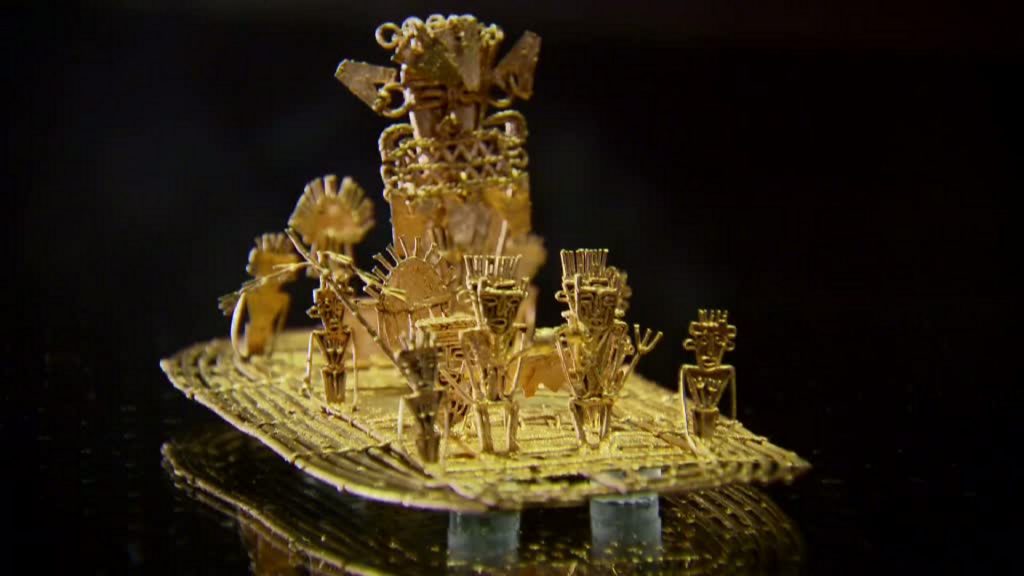Lost Kingdoms of South America episode 3: Through the mountains and jungles of Colombia, archaeologist Dr Jago Cooper goes in search of the truth behind one of the greatest stories ever told – the legend of El Dorado. His journey takes him from Bogota to the Caribbean coast, through territories once dominated by two cultures, the Muisca and the Tairona, who flourished for centuries before the arrival of the Spanish in the 16th century.
When the Spanish arrived in Muisca territory in the late 1530s, they found that everyone seemed to possess gold objects. Rumours spread far beyond the New World that there was a city of gold in the mountains: the legend of El Dorado was born. But El Dorado was a person, not a place. One Conquistador described a Muiscan chief being covered in gold dust, only to then wash it off in a lake. An exquisite artefact, discovered in a cave near Bogota and now displayed in the city’s Museum of Gold, depicts a waterborne ceremony that hints at this version of the El Dorado story.
Dr Cooper reveals forgotten peoples who valued gold in a way the western world still struggles to understand, travelling to an astonishing lost city and meeting the last survivors of an ancient civilisation. Archaeologist Dr Jago Cooper reveals the extraordinary history of some of South America’s ancient civilisations.
Lost Kingdoms of South America episode 3
El Dorado was the term used by the Spanish in the 16th century to describe a mythical tribal chief (zipa) or king of the Muisca people, an indigenous people of the Altiplano Cundiboyacense of Colombia, who as an initiation rite, covered himself with gold dust and submerged in Lake Guatavita. The legends surrounding El Dorado changed over time, as it went from being a man, to a city, to a kingdom, and then finally to an empire.
A second location for El Dorado was inferred from rumors, which inspired several unsuccessful expeditions in the late 1500s in search of a city called Manoa on the shores of Lake Parime or Parima. Two of the most famous of these expeditions were led by Sir Walter Raleigh. In pursuit of the legend, Spanish conquistadors and numerous others searched what is today Colombia, Venezuela, and parts of Guyana and northern Brazil, for the city and its fabulous king. In the course of these explorations, much of northern South America, including the Amazon River, was mapped. By the beginning of the 19th century, most people dismissed the existence of the city as a myth.
The legend of the Seven Cities of Gold (Seven Cities of Cibola) led to Francisco Vázquez de Coronado’s expedition of 1540 across the New Mexico territory. This became mixed with the stories of El Dorado, which was sometimes said to be one of the seven cities. Several literary works have used the name in their titles, sometimes as “El Dorado”, and other times as “Eldorado”
Muisca
The Muisca (also called Chibcha) are an indigenous people and culture of the Altiplano Cundiboyacense, Colombia, that formed the Muisca Confederation before the Spanish conquest. The people spoke Muysccubun, a language of the Chibchan language family, also called Muysca and Mosca. They were encountered by conquistadors ordered by the Spanish Empire in 1537 at the time of the conquest. Subgroupings of the Muisca were mostly identified by their allegiances to three great rulers: the hoa, centered in Hunza, ruling a territory roughly covering modern southern and northeastern Boyacá and southern Santander; the psihipqua, centered in Muyquytá and encompassing most of modern Cundinamarca, the western Llanos; and the iraca, religious ruler of Suamox and modern northeastern Boyacá and southwestern Santander.
The territory of the Muisca spanned an area of around 25,000 km2 (9,700 sq mi) from the north of Boyacá to the Sumapaz Páramo and from the summits to the western portion of the Eastern Ranges. Their territory bordered the lands of the Panche in the west, the Muzo in the northwest, the Guane in the north, the Lache in the northeast, the Achagua in the east, and the Sutagao in the south.
At the time of the Spaniard invasion, the area had a large population, although the precise number of inhabitants is not known. Estimates vary from half a million to up to three million inhabitants. Their economy was based on agriculture, salt mining, trading, metalworking, and manufacturing.




